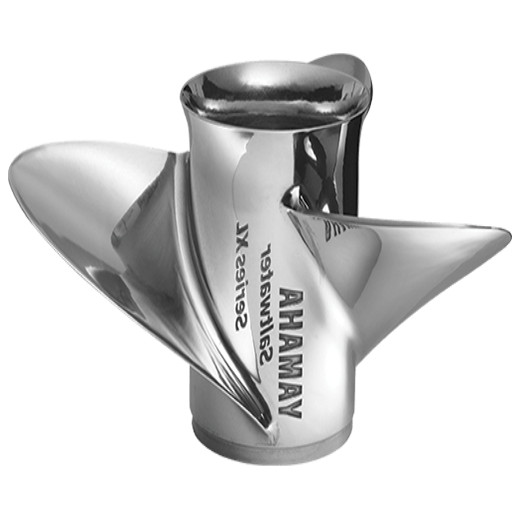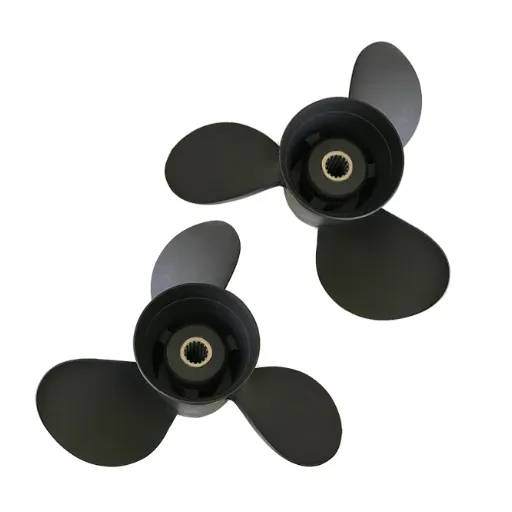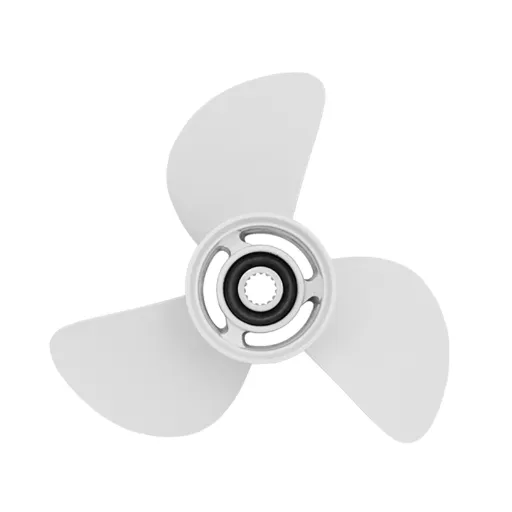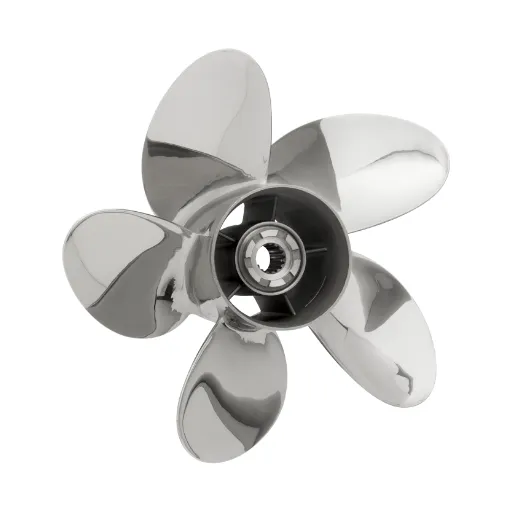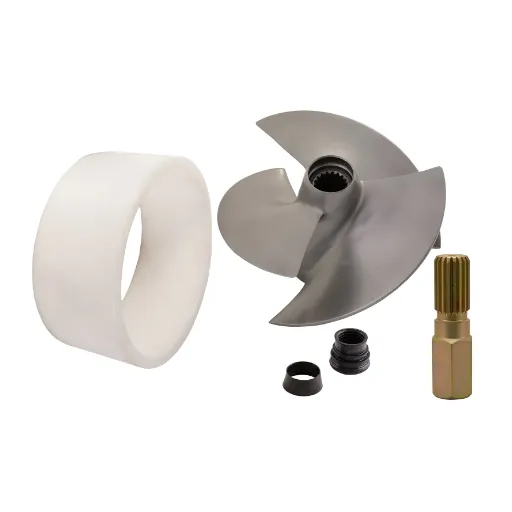Choosing the correct propeller for your Yamaha outboard can mean everything in terms of kinetics, along with fuel efficiency and overall boating. Whether you are a serious sportsman seeking speed or simply enjoy cruising and looking for a smooth ride, the propeller becomes the answer to releasing the vessel’s full potential. The 2025 guide to the best Yamaha outboard propellers will cut through the noise, offering years of expert insight and a curated list of the best options available on the market. From increased durability to maximum efficiency, we’ll discuss the propellers meant for different boating purposes to allow you to make an educated choice and get the best out of your Yamaha Outboard. Stay with us for some game-changing upgrades that will surely make your time out on the water worthwhile.
Understanding Yamaha Outboard Propellers

Types of Yamaha Outboard Propellers
There are many types of Yamaha outboard propellers available, each serving unique performance and boat preference requirements. Following are some of the main types and their characteristics:
Aluminum Propellers
Aluminum propellers are generally lightweight and inexpensive; thus, they are a preferred choice amongst average recreational boaters. They are considered lightweight propellers for light use and are disadvantaged in performance, yet come with a price tag to match. During repairs, aluminum propellers are simple to fix; hence, they scale well in shallow water or for areas where debris may cause some collateral damage to the propellers.
Stainless Steel Propellers
One of the few types of propellers that can perform heavy-duty or high-performance operations under exceptional conditions, stainless steel propeller is known for their joint strength and durability. They raise the efficiency and acceleration, which is most helpful to speedsters and water sports people. They are usually more expensive than aluminum types, but due to their capacity to resist corrosion in saltwater conditions, they compensate with long-term value.
Saltwater Series Propellers
These propellers are designed for use in saltwater environments to provide additional protection against corrosion. Generally, they are made from polished stainless steel to be more durable, with power and thrust-oriented designs, often used for larger boats or smaller vessels in outboard waters.
Performance Propellers
Engineered for maximum speed and efficiency, making them the candidates for competitive boating or those requiring greater precision handling and less resistance. Typically, these propellers feature unusual blade geometries and rake angles to ensure greater responsiveness and enhanced smoothness at high speeds.
Dual Thrust Propellers
Dual-thrust propellers are specifically designed to produce greater forward and reverse thrusts. This places heavier boats or any situation where extra low-speed maneuvering power is required, such as docking or fishing, in the limelight. The design ensures a reduction in turbulence while granting better control in rough conditions.
Reliance Series Propellers
The Reliance series is an upper-echelon propeller targeted for medium Yamaha outboards. These propellers provide accurate control, reduced ventilation, and improved acceleration. The sport boater generally prefers this series as an alternative to performance and fuel efficiency.
Each type of Yamaha outboard propeller has its own unique pitch, diameter, and blade number configurations, which can have further implications for performance. For the right result, you want your propeller to ensure fuel efficiency, speed, and handling that are appropriate for your very own boating environment and usage.
Material Choice: Stainless Steel or Aluminum?
Choosing between stainless steel and aluminum propellers involves a trade-off between performance, durability, and cost. Aluminum props are lighter and less expensive, making them more suitable for smaller craft or non-intensive boating activities. They form an excellent alternative for those who prioritize costs above all else and are working under circumstances where top speed or durability is not critical. Being of light construction, aluminum props will bend or get damaged upon hitting underwater obstacles, and hence are poor choices for more demanding conditions.
The stainless steel propellers excel in durability and performance. They offer streamlined construction, allowing their blades to be thin, which in turn reduces drag, thereby accelerating the boat and improving its top speed. Stainless steel is, further, highly resistant to corrosion, operating well under both fresh and salt water. While they may be expensive upfront, ultimate longevity may prove them worth every penny for an avid boater seeking topwärt performance and reliability. Ultimately, the choice between aluminum and stainless steel is often based on the dictates of boat usage, frequency of use, and budget.
How to Choose the Right Yamaha Outboard Propeller
Several factors should be considered when selecting the right Yamaha outboard propeller, as these factors will impact its performance, fuel economy, and overall boating experience. This serves as an excellent starting point for learning propeller dimensions, specifically pitch and diameter. The pitch, in theory, indicates how far the propeller travels in one revolution, while the diameter is the width of the circle formed by the blades as they spin. For optimal thrust and performance, one dimension should oppose another according to the specifications of their engine.
Key Selection Factors:
- Material consideration (aluminum vs. stainless steel)
- Number of blades (3-blade vs. 4-blade)
- Engine RPM range compatibility
- Boating conditions and usage patterns
Another big consideration is its material. Aluminum props are generally lightweight, inexpensive, casual-use propellers that exhibit enough performance for light-duty boating. Stainless steel, on the contrary, sets a standard for heavy and high-speed applications due to its supreme durability and hence less flex under pressure. Those who go boating in rough conditions or simply want the utmost performance would greatly benefit from installing stainless steel props.
The number of blades is also a factor to consider. Three-blade propellers are a popular choice, as they enhance a vehicle’s speed and efficiency. The four-blade variety, however, will usually provide better acceleration, handling, and a smoother ride, especially in choppy waters or when towing.
Propeller determination also rests upon knowledge of the RPM range of a boat. Maintaining the engine at optimal RPM for best performance and longevity is a fuel-efficient way to operate the engine. The right choice of propeller must fit within the recommended RPM range of your engine to ensure smooth operation and prevent unnecessary strain on the motor.
Taking these factors into consideration will help you find the propeller for your Yamaha outboard that aligns with your boating objectives for optimal performance and an enjoyable time at sea.
Recommended Yamaha Propellers for 2025
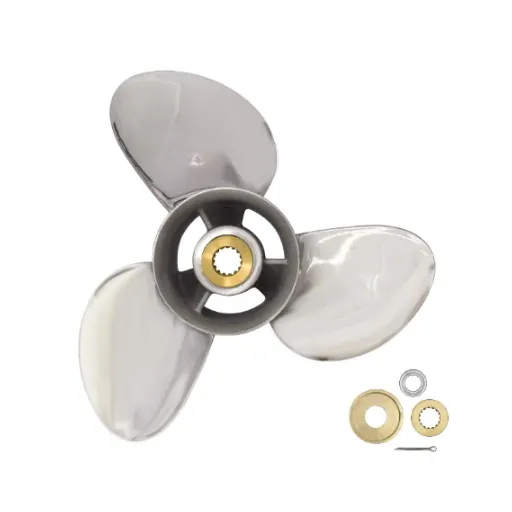
Solas Rubex: Features & Benefits
Durability, innovation, and performance-enhancing aspects make up the Solas Rubex series. One key feature of the Rubex is the rubber hub system, which absorbs vibration for smooth and silent running, while also allowing maximum engine efficiency. The propellers are made of the finest stainless steel or aluminum and are corrosion-resistant, and hence capable of lasting longer even in extreme marine conditions.
The Rubex series, on the other hand, is made with precise geometry to deliver excellent thrust and acceleration. Advanced blade design cuts drag and channels water flow precisely to improve fuel efficiency for boaters. In addition, the presentation of a wide range of pitches ensures that you can find a propeller that suits both your Yamaha engine model and your own boating needs. Faster, fuel-efficient, or all-out power: a Solas Rubex can be relied upon to deliver in a range of applications.
Sharrow Rings: A Game Changer for Fuel Efficiency
Sharrow Rings have made a significant impact by largely innovating propeller technology to enhance fuel efficiency and performance. Conventional propellers do not share the same loop blade geometry, which in turn reduces cavitation while eliminating energy-wasting waves underwater. This enables smooth operation, accompanied by tangible improvements in fuel consumption. Up to 30% of overall efficiency improvement has been demonstrated under certain boating conditions through studies and a wealth of user experience, making Sharrow Rings a favorite among environmentally minded boaters and performance enthusiasts alike. In addition to being better for the engine, along with less engine strain, they are good for longevity and less maintenance in the long term. Perfect for both commercial and recreational use, they reflect the latest engineering advancements in their modern conservation approach, promising to redefine the marine propulsion industry.
Performance Enhancements with the Latest Models
The latest Sharrow Ring models have undergone advanced engineering refinements to increase the efficiency and performance of the naval propulsion process. Using the latest techniques in hydrodynamic design, propulsion occurs with optimum smoothness and the least water resistance possible, allowing the vessel to achieve enhanced speed and fuel savings. According to the latest data, ships equipped with the latest Sharrow Rings enjoy a 20% improvement in fuel economy over traditional propellers, making them more economical for operators. Additionally, the new processes adopted during ring manufacturing ensure extra resistance to wear and improved serviceability in harsh marine environments.
Noise reduction is also greatly enhanced, thereby ensuring that the boating experience remains peaceful —a feature that is especially appreciated in recreational pursuits or for wildlife-sensitive activities. The latest Sharrow Rings thus stand as a reliable and innovative solution to modern boating requirements; a highly differentiable characteristic is their ability to maintain peak efficiency under widely varying load and speed conditions.
Performance Comparison: 3-Blade vs. 4-Blade Propellers
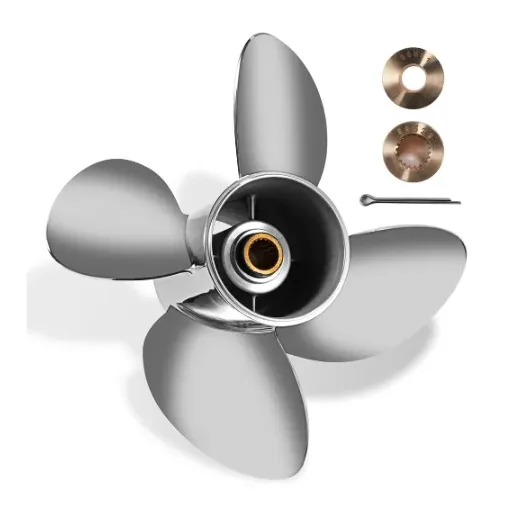
Performance Comparison Tables (3-Blade vs. 4-Blade)
Running a comparison between 3- and 4-blade propellers will need an additional evaluation of performance characteristics against clear parameters such as speed, fuel efficiency, stability, and noise levels. Here follows a more detailed account showing the differences:
| Performance Metric | 3-Blade Propeller | 4-Blade Propeller |
|---|---|---|
| Top Speed | Higher top speed due to reduced drag. | Slightly lower top speed but better handling at mid-range speeds. |
| Acceleration | Quick acceleration and responsiveness. | Smoother acceleration with reduced vibration. |
| Fuel Efficiency | Typically more fuel-efficient at high speeds. | Better fuel efficiency at cruising speeds. |
| Stability | May struggle with stability in rough waters. | Enhanced stability in rough or choppy conditions. |
| Noise Levels | Slightly noisier due to higher RPMs. | Quieter operation, beneficial in noise-sensitive areas. |
| Load Handling | Performs well with lighter loads. | Better at handling heavier loads without loss of speed. |
| Maneuverability | Offers quick turns and tighter handling. | Improved control and smoother turns, especially at lower speeds. |
Use Case
3-blade propellers are commonly employed in the high-speed domain, such as racing and lightweight recreational boating. In contrast, 4-blade propellers are used when extra stability is required, whether for towing, fishing, or working in heavy waters.
Durability and Load Performance
The additional blade provides 4-blade propellers with a slight advantage in effectively reducing stress per blade, especially under heavy workloads, thereby promoting service life and enhancing capacity for better performance under load.
The above distinctions ensure that boaters select the right prop design to cater to their specific needs, thereby ensuring optimal performance and efficiency on the water.
Torque vs. Thrust: Which one is better?
Torque and thrust: how do you tell them apart? That is an art in itself. Torque, usually expressed in lb-ft or N-m, is the turning force generated by an engine or motor, which sets the acceleration and power delivery. Torque is needed for tasks where either bursts of speed or heavy loads are encountered, such as towing or powering through choppy water. Thrust is a linear force exerted by a particular propeller or jet, propelling the vessel forward. Thrust is crucial for maintaining movement and efficiency during extended periods, especially in calm water.
The data provide information that thrust increases with increasing fuel efficiency, which is beneficial for steady operational speed, particularly during cruising. On the other hand, torque acts as a helpful force during situations of high demand, such as a bump or surge. Torque or thrust considerations depend on the case in use. Sports and fishing boats may require torque for maneuvering, while larger vessels may opt for thrust for greater endurance.
With advancements in contemporary propulsion technologies, hybrid designs are now feasible, providing an adequate balance between torque and thrust to ensure application versatility under various conditions. By considering the specific needs of the vessel for operation, including its speed range, load capacity, and typical water conditions, an optimal balance can be achieved that leads to good performance and efficiency. This also reaffirms the importance of tailoring propulsion systems to specific needs to deliver a satisfactory outcome.
User Experiences and Case Studies
Florida Case Study – 20% Fuel Efficiency Improvement
These user experiences and real-life cases provide valuable insights into the very impact of recent developments in marine propulsion systems. In Florida, a recreational boater reported a 20% increase in fuel efficiency after switching over to the hybrid propulsion designed for that particular vessel size and use. Handling was also smoother under ever-changing conditions, further illustrating the adaptability of hybrid technologies.
Pacific Northwest Commercial Operation
In another case, a commercial fishing operation based in the Pacific Northwest achieved significant reductions in maintenance costs and increased overall haul capacity by adopting an optimized propulsion design tailored to cope with the region’s unpredictable waters and heavy load demands. The result is an increase in their daily output and, consequently, improved operational efficiency.
The above examples underscore the strategic considerations that must be taken into account when selecting propulsion, including water conditions, vessel needs, and future plans. The above experiences provide tangible benefits, including cost reduction, improved performance, and sustainability, through innovation and adaptability.
Maximizing Performance with Yamaha Outboard Propellers
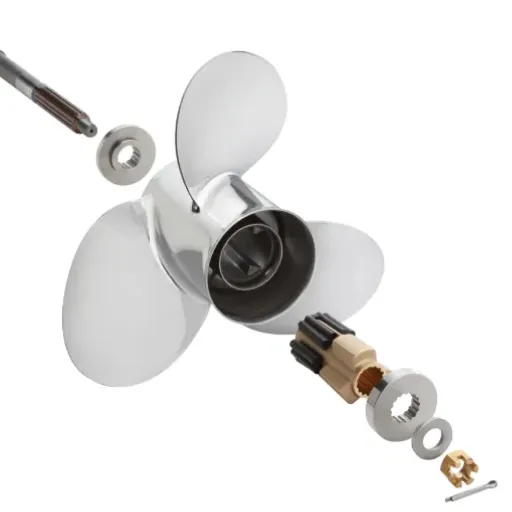
Understanding the correlation between Horsepower and RPM
Horsepower and RPMs happen to be very closely allied and work in tandem with each other to ensure that Yamaha outboard propellers perform at their best. At the core, horsepower is the capability of an engine to do work, while RPM is the rate at which an engine’s crankshaft completes one full revolution. The speeds at which the two exist determine the efficiency and speed of the vessel.
The highest RPM does not necessarily mean the highest horsepower; in fact, there exists an optimum range of RPM where the engine operates most efficiently. Operating at peak performance requires the propeller size and pitch to match the engine’s RPM range, which is typically specified by the manufacturer. The propeller for Yamaha outboard engines must be capable of allowing the engine to reach its recommended wide-open throttle (WOT) range for maximum horsepower, thereby preventing the engine from being strained or running inefficiently in terms of fuel consumption.
Important Considerations
In the case of improper high-pitch propeller selection, engines may fall short of their full flat-out speed, hence underperforming and possibly wearing out due to these abnormal operations. Inversely, a low-pitch propeller results in high RPM on the engine, thereby risking damage and reducing overall efficacy. With these variables taken into consideration, smooth handling, firm acceleration, and economy emerge as important areas for further study to underscore the need for a good understanding of Yamaha’s horsepower and RPM relationship and its application. Engine performance charts and professionals can aid in proper adjustments to ensure maximum performance.
Effect of Propeller Pitch on Boat Performance
Propeller pitch is the single most significant factor addressing speed, fuel efficiency, and overall performance of a vessel. A higher pitch means a greater distance per revolution, and a higher top-end speed is often accompanied by a loss of acceleration and low-end torque. Conversely, a lower pitch helps with acceleration and maneuverability, but limits top speed, and also results in higher fuel consumption at cruising speed. For such a balance to exist, know the major application of your boat, such as watersports, fishing, or cruising, and check its performance in terms of speed at RPM and under various conditions.
Performance Data Insight
For instance, data indicate that by selecting the proper pitch for a propeller, a 20% increase in fuel efficiency can be achieved at a comfortable cruising speed. Additionally, GPS speed tracking and tachometers can be utilized to monitor performance and inform further adjustments. Periodic tests, combined with pitch adjustments, will help keep your engine working within the manufacturer-specified RPM range, thereby prolonging engine life and enhancing boating experiences. However, always seek help from marine performance experts or use online references to obtain suggestions tailored to your specific needs and boating conditions.
Case Study: 10% Speed Increase with the Right Prop
Real-World Performance Results
Perfect prop selection and its installation on a vessel assured a respectable 10% speed advantage for the boating enthusiast. At first, the boat struggled with the aluminum propeller, which, although working, did significantly improve the boat’s speed and efficiency. After consulting a marine expert and employing cutting-edge performance tools to analyze the boat’s specific peculiarities, such as hull design, weight distribution, and engine RPM, the owner opted for an upgrade to a stainless steel, three-blade propeller with a custom pitch and diameter.
Results: 40 MPH → 44 MPH (10% Speed Increase)
The results were awe-inspiring. The top speed of the boat went from 40 MPH to 44 MPH, marking a 10% improvement, with better fuel efficiency to boot. Even more impressive was the engine running within a perfect RPM range during cruising, therefore reducing engine wear and tear. The handling was also improved for smoother turns and good stability. This represents a compelling case where the selection of a custom propeller, informed by expert knowledge and precise performance parameters, can significantly enhance the overall efficiency and constructive performance of a vessel.
Choosing the Right Yamaha Outboard Propeller
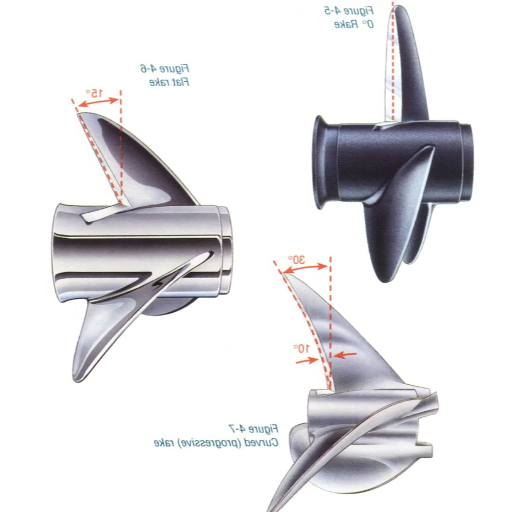
Summarizing Key Factors for Selection
First and foremost, my approach when selecting the right Yamaha outboard propeller would have to consider the specific boating requirements and goals I am looking for in terms of performance. My activities vary from cruising and fishing to watersports, and the choice may depend on the occasion. Additionally, I consider the weight and specifications of my boat, as distance and speed are related to efficiency in terms of weight loading. Knowing the diameter and pitch intentions will ensure that my engine’s RPM range aligns with the best performance in terms of speed, mileage, and overall efficiency.
Also, I categorize materials and designs based on durability and intended use. Stainless steel propellers are ideal for withstanding harsh treatments and operating at higher speeds, while aluminum alternatives are lighter and more economical for general applications. I’ve also learned the importance of checking the performance of my existing propeller. Determining if it causes my engine to operate at the RPM recommended by the manufacturer and giving smooth handling helps me assess areas where improvement is required. Finally, I am depending on professional opinions and performance information, such as GPS speed readings and fuel consumption data, to make an accurate and educated choice about the propeller.
Expert Recommendation Summary
If you go through weighing these factors and, if necessary, seek recommendations from experts, then you can work on improving your boating experience and engine health in the long run. Taking the time to find a propeller that fits just right will always pay off in terms of overall performance, fuel efficiency, and satisfaction on the water.
Future Trends in Outboard Propeller Technology
The automotive industry is poised to face a very exciting trend: the convergence of innovative materials and digital automation in outboard propeller technology. The developments in materials science are laying down a path for the design of lightweight yet tough propellers that can change shape on their own to optimize performance for various conditions. For instance, blades of adaptive propellers made from materials such as shape-memory alloys enable in-water recalibration, thereby increasing fuel economy and speed. Such immense accommodation would greatly enhance the overall boating experience, especially for those who frequent waters with varying conditions or who have different performance capabilities.
AI & IoT Integration
Another hopeful development is the increasing use of AI and IoT-enabled sensor technologies in propeller systems. Such smart systems can record and analyze performance data in real-time, providing operators with clues on how to reduce drag, conserve fuel, or optimize speed. I firmly hold this view: this will be the boon to cutting down operational costs and improving engine life. I can thus imagine a connected system setup where maintenance schedules are triggered in advance, issues are paged, and a carefree patron experience is guaranteed.
Sustainability Focus
And last, but by no means least, a prominent place will be reserved for sustainability in the emerging propeller designs. Manufacturers are turning to use green materials and designs that impact nature as little as possible, while still meeting the criteria for high performance. What excites me is the prospect of maintaining efficiency at its bare minimum while incorporating eco-friendly practices, for I am well aware that striving in this direction is essential if anything is to be done to conserve our waterways for future generations. All in all, these developments fill me with hope about the future of outboard propeller technology and its potential to dramatically transform the boating world.
Final Recommendations for 2025 Yamaha Propellers
2025 Strategic Recommendations
Given the green design evolution and performance optimization, the 2025 Yamaha propeller recommendations focus on sustainability, durability, and increased efficiency. For one thing, I insist that materials with less environmental impact should be given the highest priority, such as recyclable metal alloys and biodegradable composites, among other options. This is both in line with an ecological mentality and an appeal to the consciousness of environmentally conscious potential customers. Incorporation of such materials in Yamaha’s propeller line would enable Yamaha to share in the large ground-level movement of consumers pushing for responsible manufacturing, thereby retaining a high lifespan and customer reliability.
Additionally, I recommend investing more in hydrodynamic innovations to enhance fuel efficiency. Any design of a propeller that reduces drag and improves thrust output will help lower fuel consumption across various engine types, benefiting both boat operators and the environment. More advanced testing technology could be incorporated into the new designs, including virtual simulation and on-water trials, to ensure that design and performance are at the highest levels, leading to improved end-user results.
Finally, the 2025 propellers could be differentiated by Yamaha in terms of modularity and customization, allowing them to be tailored to specific performance requirements. This versatility will certainly add value to those segments involved with diverse boating from recreational to commercial applications. Yamaha can join engineering excellence, sustainable materials, and user-centric design to deliver an industry standard in its next-generation propellers. I strongly believe that this step would not only solidify Yamaha’s position in propeller technology but also pave the way for meaningful, sustainable advancements in boating.
Reference Sources
-
-
Yamaha Propeller Selector
A tool that provides propeller recommendations based on your specific boat and engine setup. -
Propellers for Medium & Small Boats – Yamaha Outboards
Features popular Yamaha propellers, including the Turbo 1, known for its all-around performance. -
Yamaha – Outboard Propellers – Prop Shop Inc.
Offers a wide range of Yamaha outboard propellers, including brands like Michigan Wheel and Solas. -
Yamaha F90 Prop Advice – The Hull Truth
A forum discussion with recommendations and reviews of propellers for Yamaha F90 engines. -
Yamaha Propellers 20-30hp – Get A Prop
Offers a variety of Yamaha propellers in aluminum and stainless steel for outboard motors with 20-30hp engines. - Click here to read more
-
Frequently Asked Questions (FAQs)
What are the advantages of Yamaha stainless steel propellers?
Some benefits of Yamaha stainless steel propellers include greater durability and resistance to wear and tear compared to aluminum props. Faster speed and improved efficiency at higher RPM are offered by these. In the meantime, stainless steel props increase fuel economy and provide better holding in rough water; hence, they are a perfect choice for large offshore boats or for anyone wishing to maximize horsepower. Therefore, a Yamaha stainless steel set would very well be a sound investment for the serious boater.
How do I select a propeller for my Yamaha outboard engine?
Choosing the right propeller for your Yamaha outboard motor depends upon several factors, including the type of boat, desired speed, and horsepower. RPM range is yet another vital consideration; a given prop can perform quite differently at different RPMs. Yamaha offers a free prop selector program, which helps determine the best propeller for your specific engine, such as the F115 or other in-line four-cylinder outboards. Additionally, consider the prop diameter and blade configuration, whether three-blade or four-blade, based on your cruising and speed requirements.
What should I understand about the ventilation of a Yamaha outboard propeller?
Ventilation can cause a significant effect on the process of thrust generation through any propeller for an outboard from Yamaha. It occurs when air enters the water through the propeller blades, thereby reducing the suction force and accelerating the engine. To avoid ventilation issues, it is vital to select the prop size and design carefully. A painted stainless steel prop resists ventilation. Ventilation becomes an issue in rough waters, and this is especially true when an inexperienced pilot is handling the boat. Therefore, attention must be paid to the handling characteristics of the ship so that it can be fitted with an appropriate outboard prop. The problem of ventilation can be reduced by ensuring good maintenance of the entire system.
What is the difference between aluminum and stainless steel Yamaha props?
Aluminum Yamaha props generally have the advantage of being lighter and less expensive than stainless steel, making them more appealing to the recreational market. On the other hand, the stainless steel prop offers excellent performance, boasting good durability and speed. Being able to stand higher horsepower, it has better handling in rough water. Additionally, stainless steel propellers have a longer lifespan and can be repaired more easily than aluminum ones. Which one you go for, aluminum or stainless, will depend on your frequency of boating, conditions, and the type of performance you want.
What effect does blade design impart on the performance of outboard props?
Blade design is crucial for Yamaha outboard prop performance. Three-blade characteristics typically emphasize speed and fuel efficiency, while four-blade characteristics provide better handling and control in rough conditions. Blade numbers, shape, and pitch affect the lift and thrust generated by the blades, which in turn have a bearing on the vessel’s acceleration and top speed. You have a choice between smaller-diameter and larger-diameter propellers, but understanding whether blade design affects performance will help you determine the best propeller for your specific needs on the water.
Can I use Yamaha outboard props for trolling with my F70-F115?
Of course! You can engage in trolling with Yamaha outboard props with your F70 – F115 engines, but picking the right prop for trolling is an important job. Those designed for trolling generally feature a lower pitch, allowing the boat to come under control at very low speeds while maintaining good fuel efficiency. You want the props promoting quiet shifting and trolling, so you’ll never scare the fish away! It is good to use Yamaha’s prop selector tool or ask a good marine professional to ensure you buy the best outboard prop for your trolling needs.




